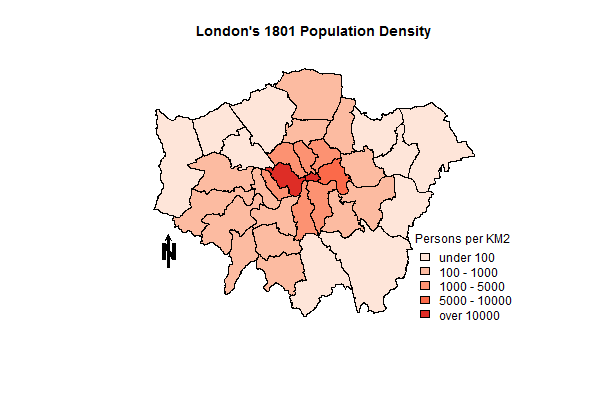animated map in R
Take a look at the animation package. One of the functions worth exploring, that does not require 3rd party software, is "saveHTML".
Using the "saveHTML" function in the animation package is very straight forward. Here is example code where I create an animation of a randomized population change. The "expr" argument defines the plotting function you want to pass to the animation. As you can see in the below code I used a for loop to plot each simulated column.
require(animation)
require(sp)
require(RColorBrewer)
require(classInt)
# Load your data and add random population change column
load(url("http://www.gadm.org/data/rda/GBR_adm2.RData"))
for( i in 1:10 ) {
gadm@data[paste("Year",i, sep="")] <- runif(dim(gadm)[1],0,1)
}
# Create HTML animation using for loop for each simulated column
saveHTML(
for(x in names(gadm@data)[19:28]) {
ani.options(interval = 0.5)
plotvar <- gadm@data[,x]
nclr <- 9
plotclr <- rev(brewer.pal(nclr,"BuPu"))
cuts <- classIntervals(plotvar, style="fixed",
fixedBreaks=c(0,0.1,0.2,0.3,0.4,0.5,0.6,0.7,0.8,1))
colcode <- findColours(cuts, plotclr)
plot(gadm, col=colcode, border=NA, ylim=c(bbox(gadm)[,1][2], bbox(gadm)[,2][2]),
xlim=c(bbox(gadm)[,1][1], bbox(gadm)[,2][1]))
text(min(bbox(gadm)[1]), min(bbox(gadm)[2]), paste("Population Change",x,sep=" "))
box()
legend("topleft", legend=c("0-10%","10-20%","20-30%","30-40%","40-50%",
"50-60%","60-70%","70-80%","80-100%"),
fill=attr(colcode, "palette"), cex=0.6, bty="n")
ani.pause()
},
img.name="RandPopChange", htmlfile="SimPopChange.html",
single.opts = "'controls': ['first', 'previous', 'play', 'next', 'last', 'loop', 'speed'], 'delayMin': 0",
description=c("Random population change:"))
I edited the post to provide a more relevant example based on polygon columns.
The animation that you linked (below) is an animated GIF image.

It is essentially a series of images that are cycled through, which creates the animation effect. Think of it like clicking through a series of slides, one every second or so.
What you need to do in order to create the animation is:
1) Create each individual 'frame' that will be shown.
2) Create the GIF itself. There are several websites that will do this for you:
http://www.createagif.net/
http://makeagif.com/
Most of these websites will allow you to control the size and speed of the animation.
The StackOverflow question you linked to should provide you with everything you need to know to perform this task in R. Notice that you have to install a 3rd party package first.
EDIT: Below is an updated version of the code from the StackOverflow link above since there seems to be a bit of confusion.
jpeg("/tmp/foo%02d.jpg")
for (i in 1:5) {
my.plot(i)
}
make.mov <- function(){
unlink("plot.mpg")
system("convert -delay 0.5 plot*.jpg plot.mpg")
}
dev.off()
This above code takes each of the individual plots you have created in R and converts them into an animation by looping over each and using ImageMagick, which you must have installed.
This is as far as I go. You should be able to figure it out based on this code. Once again, since your problem is not reproducible I had to create dummy data to illustrate the solution. One odd aspect in using spplot is that since it uses lattice to create the plot you need to create an object and then print the object. Otherwise you do not get a plot.
require(animation)
require(sp)
require(RColorBrewer)
require(classInt)
require(rgdal)
load(url("http://www.filefactory.com/file/4h1hb5c1cw7r/n/RUS_adm1_RData"))
closeAllConnections()
# Set color palette
myPalette <- brewer.pal(6,"Purples")
# Reproject data
gadm <- spTransform(gadm, CRS("+init=epsg:3413 +lon_0=105"))
# Create dummy unployment data with 10% change in gadm object
gadm@data$uemp2000 <- runif(dim(gadm)[1],0,50)
gadm@data$uemp2001 <- gadm@data$uemp2000 + (gadm@data$uemp2000 * 0.10)
gadm@data$uemp2002 <- gadm@data$uemp2001 + (gadm@data$uemp2001 * 0.10)
gadm@data$uemp2003 <- gadm@data$uemp2002 + (gadm@data$uemp2002 * 0.10)
gadm@data$uemp2004 <- gadm@data$uemp2003 + (gadm@data$uemp2003 * 0.10)
gadm@data$uemp2005 <- gadm@data$uemp2004 + (gadm@data$uemp2004 * 0.10)
# Coerce into factors with defined levels
for( i in c("uemp2000","uemp2001","uemp2002","uemp2003","uemp2004","uemp2005") ) {
gadm@data[,i] <- as.factor(as.numeric(cut(gadm@data[,i],
c(0,2.5,5,7.5,10,15,100))))
levels(gadm@data[,i]) <- c("<2,5%", "2,5-5%", "5-7,5%",
"7,5-10%", "10-15%", ">15%")
}
saveHTML(
for(i in c("uemp2000","uemp2001","uemp2002","uemp2003","uemp2004","uemp2005")) {
sp.plot <- spplot(gadm, i, col=grey(.9), col.regions=myPalette,
main=paste("Unemployment in Russia", i, sep=" - ") )
print( sp.plot )
},img.name = "map", htmlfile = "unrus2.html")